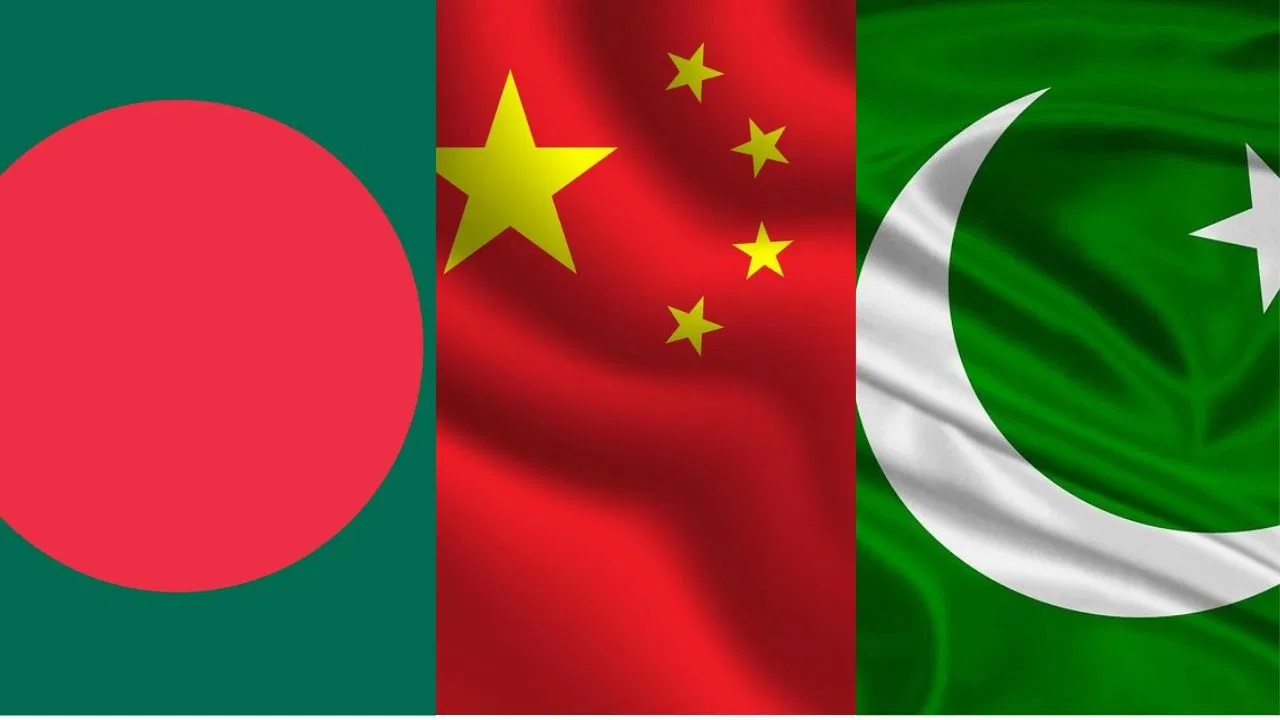China-Pakistan-Bangladesh Trilateral: Implications for India’s Neighbourhood Strategy
Context
Recently, China hosted the first-ever trilateral meeting with Pakistan and Bangladesh in Kunming, China.
This development highlights China’s growing efforts to reshape South Asian geopolitics by forging alliances with India's neighbours and isolating New Delhi from regional affairs.
What is the China-led Trilateral Nexus?
-
This trilateral initiative is part of China’s larger geo-strategic plan to encircle India by forming close partnerships with its neighbouring countries like Nepal, Bangladesh, and Sri Lanka.
-
Objective: To weaken India’s geopolitical and economic influence in the region and increase China’s control and presence.
-
Strategy: Using diplomatic and economic tools to create alternative regional groupings that exclude India.
Historical Attempts to Isolate India
-
1965 Strategy: Pakistan proposed using East Pakistan, Nepal, and China to cut off India from the strategic Siliguri Corridor.
-
1962 War Legacy:
-
The India-China war altered regional alignments.
-
Post-war, China viewed Pakistan as a strategic partner to divert India’s attention from Beijing’s interests.
-
Pakistan, in return, saw China as a source of unconditional military and economic support.
-
Current China-Pakistan Military and Economic Nexus
-
Debt Dependency: As of end-2024, Pakistan owes China over $29 billion in loans.
-
Military Imports: More than 80% of Pakistan’s arms imports come from China.
-
Chinese Military Support: Pakistan deploys Chinese-made drones, radars, guidance systems, missiles, and fighter jets.
-
Terrorism Shield: China has consistently blocked efforts at the UN Security Council to sanction Pakistan-backed terrorists.
Recent Trilateral Engagements by China
-
Bangladesh Trilateral: Discussions focused on enhancing economic and strategic cooperation.
-
Afghanistan Trilateral (May 2025): Aimed at extending the China-Pakistan Economic Corridor (CPEC) and increasing regional connectivity.
Regional Political Climate
-
India's Ties with Afghanistan are strengthening, while Pakistan’s relevance is diminishing.
-
India-Bangladesh relations have recently been strained, creating space for Chinese influence.
-
These trilaterals are attempts to:
-
Reinstate Pakistan’s role in regional diplomacy.
-
Keep India engaged with local security concerns.
-
Promote China’s Belt and Road Initiative (BRI) interests.
-
Why is China Reinitiating the Trilateral Nexus Now?
-
India’s Assertive Posture:
-
India has responded firmly to terror attacks in Uri (2016), Pulwama (2019), and Pahalgam.
-
After Pahalgam, India:
-
Suspended Indus Waters Treaty
-
Restricted trade and port access
-
Targeted Pakistan’s military infrastructure
-
-
-
Diplomatic Prowess:
-
India used its global influence to diplomatically isolate Pakistan.
-
Strong responses in Doklam and Galwan surprised China.
-
-
Growing Global Standing: India is now seen as a rising power, prompting China to create strategic distractions.
-
China’s Declining Influence: Due to India’s regional engagement, China’s momentum in South Asia has slowed down.
Improving Bangladesh-Pakistan Relations
-
Following regime change in Bangladesh, ties with Pakistan have warmed.
-
Key Developments:
-
Bangladeshi Navy participated in Aman 2025 naval exercise in Karachi after 12 years.
-
For the first time since 1971, the two countries resumed direct trade in March 2025.
-
Current Geopolitical Trends in South Asia
-
Maldives: Despite anti-India rhetoric by President Muizzu, China is cautious due to the country’s economic instability.
-
Nepal: Although part of BRI, there are funding disagreements and slow project progress.
-
Sri Lanka: President Anura Kumara Dissanayake is maintaining close ties with India.
-
Bangladesh-Nepal-India Energy Cooperation continues despite political differences, showing India’s mature regional approach.
Implications of the Trilateral Nexus
-
Security Threats: The China-Pakistan-Bangladesh axis may escalate terrorism and cross-border tensions.
-
Undermining India’s Influence:
-
China’s moves may reduce India’s strategic leverage with its neighbours.
-
Pakistan could regain regional significance with Chinese backing.
-
-
Opportunity for China: A preoccupied India allows China to push BRI projects, economic control, and infrastructure development.
-
Challenges India’s Anti-Terror Strategy: These groupings may counter India’s efforts to build a unified front against terrorism.
-
Shift in South Asian Balance: Countries may be forced to balance between China and India, leading to strategic confusion.
What Lies Ahead for India?
-
China’s increasing role, not Pakistan, is India’s primary strategic challenge in South Asia.
-
India’s Options:
-
Strengthen bilateral diplomacy with neighbours like Bangladesh, Nepal, and Sri Lanka.
-
Enhance regional cooperation via platforms like SAARC and BIMSTEC.
-
Clearly communicate redlines to neighbours regarding security and territorial concerns.
-
Promote economic integration and connectivity projects led by India.
-
Conclusion
China’s trilateral diplomacy is aimed at reshaping South Asia's political order and marginalising India’s influence.
India must respond through assertive diplomacy, economic partnerships, and strategic clarity to safeguard its interests and maintain regional stability.




Comments (0)